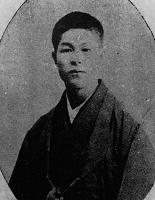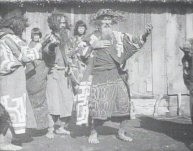October
|
The Konishi Honten photography shop (later known as Konishiya Rokubeiten and now Konica Minolta) located in Nihonhashi ward, Tokyo, imports the first film camera, a British Baxter & Wray Cinematograph. Peter B. High writes it had been a French Gaumont and that had been imported in June. The Nihon Eiga Terebi Gijutsu Kyokai's (Motion Picture and Television Engineering Society of Japan, Inc.) publication sets the date in September. Meanwhile, Yoshiro Irie quotes an advertisement appearing in the October's issue of Konishi's own magazine, Shashin Geppo (Photography Monthly), in which it is announced the arrival of a film camera. Shiro Asano, an employee at the head office of Konishi, used this camera to shoot street scenes in Nihonbashi, Asakusa and Ginza, so it is believed that he was the first Japanese to successfully complete the whole process of shooting, developing and printing film.
Though the standard works on Japanese film history set Nihonbashi as the first scenery filmed by Asano with the new camera, Asano, in several interviews, contradicts himself with regards to his filming chronology. Hiroshi Komatsu argues that the first film was shot from the rooftop of a building in Nihonbashi, near the Konishi shop, and then he filmed KAKUBEIJISHI (The Lion Dance), a street performance of the dance that took place at the front of the shop. This claim is backed by Asano's and the then executives of Konishi Honten's recollections of the event during a symposium (Yonju-nen Mae no Satsueiki to Satsuei o Kiku) later reproduced in an article published by Kinema Junpo in January 1940, perhaps the most famous source related to this period in Japanese cinema history.
However, in this meeting Asano declared that before filming at Nihonbashi and Asakusa he shot at least two couple of reels of film to test the camera and check the result. In an earlier publication by Jouji Tamaichi titled Katsudosashi no Shishiki (1927), Asano stated that his first films had been KAKUBEIJISHI and then ISHIHARA MASATOSHI TO IU HITO GA GOSHAKU NO TAKAI GETA O HAITE ARUKU NO, about actor Ishihara walking along the street in high geta. In this article, first detailed account of Asano, there is no mention of any filming in Nihonbashi. More than three decades later, in a conversation with Genjiro Kobayashi, Asano told how that he shot a passing performance of the dance Kabubeijishi from the front of the shop to test the camera, and later he filmed in Nihonbashi. Asano maintained in the 1927's article and later in a conversation published in 1962 that during the dance performance he only managed to film the dancers' feet. On the other hand, according to Sugiura Sennosuke, at that time Konishi's managing director, in a conversation published in 1953, the first film shot was NIHONBASHI UE NO TETSUDOUBASHA (Horsecar at Nihonbashi), followed by KAKUBEIJISHI and ASAKUSA KANNON NO HATO (Pigeon at Asakusa Kannon).
Except for a reproduction of a film frame believed to belong to the Nihonbashi actuality, there is not any other visual evidence of any of these films. Interestingly enough, this film frame has not even escaped controversy. As Yoshiro Irie clearly demonstrates in his extremely revealing article Saiko no Nihon Eiga ni Tsuite - Konishi Honten Seisaku no Katsudoshashin, several film historians have given different titles (for example NIHONBASHI, NIHONBASHI KYOUHAN, or the above mentioned NIHONBASHI UE NO TETSUDOUBASHA) to the actuality film to which this frame belongs and even locations (either Nihonbashi or Ginza) where it was filmed. Juxtaposition with photographs from the same period have nevertheless confirmed the spot as Nihonbashi. It is also quite possible that NIHONBASHI could have been included in the first public shows of Japanese-made films. Though not the first projection of Japanese films recorded, the exhibition held at the Meiji-za theatre between 14-31 July 1899, featured a film titled NIHONBASHI KUBIMACHI. A movie listing had been advertised in the Houchi newspaper on 13 July, and although it is the oldest document giving a relatively good account of each Japanese film projected, their contents and creators' names are sadly omitted. Thus far there is not conclusive proof to confirm that the film presented as NIHONBASHI KUBIMACHI was the same one filmed by Asano.
Sources:
Yoshiro Irie Saiko no Nihon Eiga ni Tsuite - Konishi Honten Seisaku no Katsudoshashin (The Earliest Japanese Movie Å\ Motion Pictures Produced by Konishi Honten), MOMAT Research, 2009, Vol 13, pp.65-91.
Usui, Michiko The Roots of Japanese Movies as Seen in the Tsubouchi Memorial Theatre Museum Collection.
Hiroshi Komatsu, Some Characteristics of Japanese Cinema before World War I, in Reframing Japanese Cinema, Ed. Arthur Nolletti and David Desser, Indiana UP, 1992, p. 232-4.
Hiroshi Komatsu, The Lumiere Cinematographe and the Production of the Cinema in Japan in the Earliest Period, Film History Vol. 8, No. 4, International Trends in Film Studies (1996), p. 436-7.
Peter B. High, The Dawn of Cinema in Japan, Journal of Contemporary History, Vol. 19, 1984, p. 32.
Nihon Eiga Terebi Gijutsu Kyokai, Nihon Eiga Gijutsu Shi, 1997, p. 21.
|
 Shiro Asano
Shiro Asano
|


